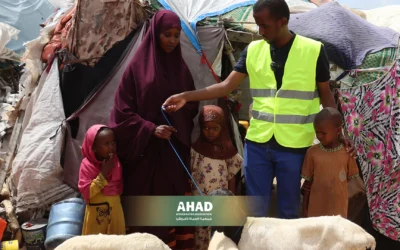Drought threatens lives in Uganda
Drought is a serious environmental challenge that causes worsening weather and water shortages, affecting the daily lives of individuals and communities on a large scale. Drought is a growing problem in many African countries, including Uganda, as it causes catastrophic impacts on agriculture and food security, threatens environmental degradation and a decline in environmental and economic sustainability.
Uganda, as a country located in East Africa, is facing special drought challenges, which makes it vulnerable to acute water shortages, low agricultural productivity and increasing poverty. The effects of drought are not just limited to agriculture, but extend to its effects on local communities and the economy in general.
In this article, we will discuss in detail how drought threatens life in Uganda, analyze the causes and effects, as well as what actions can be taken to address this serious environmental challenge. We will also discuss the importance of promoting awareness and education about the sustainability of Water Resources and protecting the environment from the increasing effects of drought.
Effects of drought in Uganda
Drought is a major challenge in Uganda, it negatively affects many aspects of the life of the population and the national economy in general. In this section, we will discuss the main causes of drought in Uganda and its effects on agriculture and food security, as well as environmental and social impacts.
The main causes of drought in Uganda
Climate change and natural phenomena
Uganda is experiencing frequent changes in rainfall patterns and cycles, leading to prolonged periods of drought the effects of El Nino and El Nino phenomena contribute to significant fluctuations in climate and rainfall in the region.
Management of unsustainable water resources
The use of inefficient irrigation systems increases water waste, which reduces the efficiency of agricultural water use.
Land degradation due to desertification further complicates the problem of drought in Uganda.
Forest decline and biodiversity
– The lack of biodiversity and the decline of vegetation reduces the ability to store and conserve water.
Effects of drought in Uganda
Agriculture and food security
– The decline in crop production due to lack of water negatively affects food security.
– Rising food prices and increasing hunger rates in the affected areas.
Water and sanitation
– Water shortage affects public water supply and sanitation, increasing the spread of infectious diseases.
– Increasing difficulty in accessing clean drinking water in the affected places.
Wildlife and ecology
– Drought threatens biodiversity and wildlife, increasing the risk of extinction of plant and animal species.
– Contributes to the degradation of the environment and the increase of harmful natural phenomena such as desertification.
Response and measures
Improving water management
– Promote effective and sustainable irrigation systems.
– Improve water resources management and enhance endurance.
Promoting sustainable agriculture
– Promotion of sustainable and drought-resistant agricultural techniques.
– Promote hydroponic harvesting and traditional irrigation techniques.
Promotion of awareness and education
– Promoting awareness of the importance of conserving water resources and the environment.
– Promote education about the risks of drought and how to respond to them.
Drought is a major life-threatening challenge in Uganda and requires an immediate and effective response to minimize its negative impacts. By investing in water management and sustainable agriculture, the country’s ability to adapt to drought challenges and improve the quality of life of the affected population can be strengthened. Preventive and educational measures are key to addressing the drought challenge and maintaining long-term resource sustainability in Uganda.
Actions that can be taken to overcome drought in Uganda
To address the drought challenge in Uganda, several actions and measures can be taken that will help reduce its impacts and increase the resilience of communities. Here are some actions that can be taken::
1. Improving water resources management
Construction and maintenance of dams and improvements in irrigation networks to increase the efficiency of agricultural water use.
Promote modern and sustainable irrigation technologies such as drip irrigation and improved irrigation.
Improve land management to reduce desertification and agricultural erosion.
2. Promoting sustainable and drought-resistant agriculture
Promote the cultivation of crops that are drought tolerant or adapted to climatic fluctuations.
Promote sustainable agricultural techniques such as hydroponic harvesting and successful crop cultivation in dry environments.
3. Promotion of awareness and education
Raising awareness of the population about the methods of sustainability of Water Resources and the effects of drought.
Promote awareness of the importance of Environmental Protection and biodiversity to improve the resilience of the ecosystem to drought.
4. Policy and legislative development
Develop clear and effective policies for the sustainable management of Water Resources.
Develop and implement strong environmental laws to protect natural resources and sensitive areas.
5. Emergency response and crisis management
Develop integrated response plans to address crises caused by drought.
Providing food and water assistance to areas acutely affected by drought.
6. International cooperation and modern technologies
Promote international cooperation to exchange experiences, knowledge and technology to combat drought.
Adopting modern technologies such as desalination technologies and solar energy to increase the country’s water management capacity.
Addressing drought in Uganda requires coordinated and multidimensional efforts that include preventive and educational measures, strengthening resilience and effective crisis response. By taking these actions and measures, Uganda can reduce the effects of drought on local communities and maintain the long-term sustainability of Natural Resources.

The importance of awareness and education in the face of drought: protecting water resources and the environment in Uganda
Promoting awareness and education about the sustainability of Water Resources and protecting the environment from the increasing effects of drought is of great importance in Uganda and many developing countries that are experiencing this environmental challenge. Here are some important reasons for this importance:
1. Promote awareness and education to reduce excessive water consumption
Promoting awareness helps to use water more effectively and sustainably, reducing waste and increasing the efficiency of its use in agriculture, industry and food.
Education helps to reduce pollution from industrial and agricultural waste that causes water pollution, improving the quality of available water.
2. Environmental Protection and biodiversity
Awareness and education contribute to the protection of forests, swamps, rivers and lakes, which play an important role in providing water and biodiversity.
Education contributes to the promotion of techniques and practices that reduce desertification and improve the quality of agricultural land.
3. Enhancing resilience and drought response
Education and awareness-raising help to prepare emergency plans to cope with drought, and provide assistance to the affected population.
Education helps to promote exchanges between countries and organizations to improve policies and legislation related to water management and agriculture.
4. Promoting sustainable development
Education contributes to the promotion of sustainable and drought-resistant agricultural techniques, which helps to achieve food security in the country.
It promotes education about resource sustainability and environmental protection by supporting economic growth in commercial and industrial ways that reduce water consumption and negative impacts on the environment.
In general, promoting awareness and education about the sustainability of Water Resources and protecting the environment from the increasing effects of drought can contribute to improving the quality of life and affected communities and economies. By investing in these aspects, Uganda could be able to better adapt to the environmental and economic challenges posed by extreme weather conditions.
Ahad promotes life and sustainable development in the heart of Africa
AHAD works in the heart of the African continent, especially in the countries of Central and West Africa, with the aim of improving the quality of life of the poor and disadvantaged in those regions. AHAD offers multiple projects in the fields of health, education, water and economic development with the aim of promoting sustainable development and achieving tangible improvements in the lives of individuals.
AHAD understands the unique nature of the communities it works with, and adopts strategies that enable it to make the most of the skills and capabilities of local people. Drawing on these strategies, AHAD works to strengthen the participation and influence of local people in building their communities towards sustainable development.
Ahad relies on the motto “because it’s worth living”, and works hard to achieve this motto in every project it undertakes. The organization seeks to achieve a tangible positive impact in the lives of the communities it serves, by providing basic needs, improving the quality of education, and empowering individuals to participate effectively in building productive and sustainable communities.
You can visit the AHAD website to find out more about the projects it offers
ALSO READ
WHAT THE FOOD BASKET CONTAINS IN AHAD
Join us in our message







